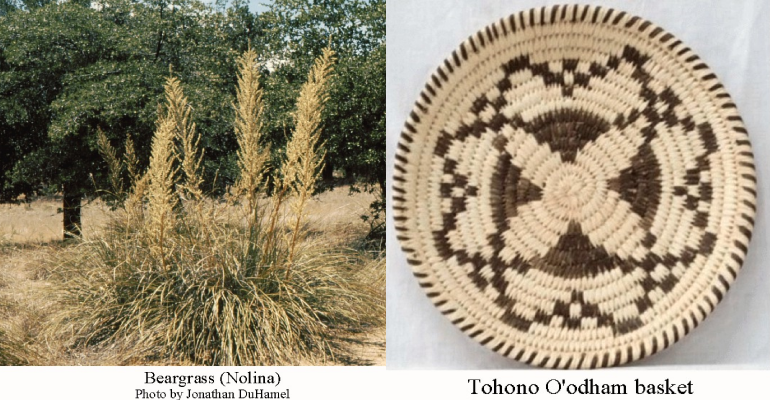
The yucca-like plants known as Beargrass (genus Nolina with several species) is widely used by native people in the southwest to weave baskets, make brooms, and used as roof thatching. It also provides food. Nolina bigelovii is the common northern Sonoran Desert species of this genus. Nolina microcarpa (colloquially called sacahuista) is another common species. Nolina occurs throughout Arizona, New Mexico, northern Mexico, and west Texas generally from 3,000 feet to 6,500 feet in elevation. It generally grows in habitats such as desert grasslands, pinyon-juniper woodlands, and chaparral. You can see some good photos here and here. (Note: the taxonomic classification of Nolina is controversial and keeps changing from the agave family to the lily or asparagus family and back.)
Beargrass grows from a large underground caudex (root stem) that produces narrow green leaves about three feet long and, in the summer, tall flower stalks. The stalks carry hundreds of tiny greenish-white flowers, which turn into papery, inflated, translucent, greenish-yellow seed capsules after pollination. The overall appearance of the plant is that of a greenish plume which dries to a straw color.
For basket weaving, the long, fibrous beargrass leaves are torn lengthwise to the desired width, then soaked in water which makes them very pliable. Upon drying they become very stiff. Basket designs include the contrasting black color from fibers of Devil’s Claw. See some examples of Tohono O’odham basketry here.
The Coahuila Indians ate N. bigelovii flowering stalks after roasting them in pits according to the Arizona-Sonora Desert Museum. Native American groups have also eaten the fruit, used the stalks as a vegetable, and ground the seeds into flour for bread according to University of Arizona Pima County Cooperative Extension.
Nolina provides food for animals such as white-tailed deer. However, buds, blooms, and seeds are toxic to sheep and goats, and less so to cattle. (Source: Rankins, D. L., et al. (1993). Characterization of toxicosis in sheep dosed with blossoms of sacahuiste (Nolina microcarpa). Journal of Animal Science 71 2489-2498.)
Beargrass is often used as an accent plant in desert landscaping.
For more ADI articles on desert plants, see:
Agaves provide food, fiber and adult beverages
Cactus water will make you sick
Chain-fruit and teddy bear cholla cactus
Chiltepin peppers, spice and medicine
Desert Broom – another medicinal plant
Desert Tobacco, a Pretty but Poisonous Desert Plant
Devil’s Claw provides food, fiber and medicine
Guayacán a pretty flowering tree
Invasion of the Popcorn Flowers
Joshua Trees of the Mohave Desert
Medusa’s Head a strange and useful plant
Mesquite trees provide food, fuel, medicine, and more
Oak trees of the Sonoran Desert region
Ocotillo – an aide to hummingbirds and geologists
Palo brea trees and their uses
Palo Verde trees about to turn the desert golden
Sacred Datura – pretty, poisonous, and hallucinogenic
Saguaro Cactus Icon of the Sonoran Desert
Spectacular flowers of the red Torch Cactus
Staghorn and Buckhorn Cholla Cactus
